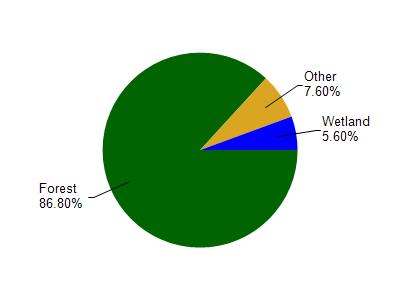Bayfield
Yes
Yes
No
Fish and Aquatic Life
Overview
The Onion River is a high-quality, spring-fed trout stream that flows into Lake Superior at a small coastal estuary connected to the Sioux River wetland complex. Wetlands fringe the lower reaches of the river, an area primarily privately owned. This stream supports a Class I trout fishery and is classified as an outstanding resource water. A number of spawning trout and salmon species use the river, including brook, brown and rainbow trout, and pink and coho salmon. The Lake Superior Binational Program has identified this river and its estuary as important to the integrity of the Lake Superior ecosystem for coastal wetlands, vital functions for planning objectives, and fish and wildlife spawning and nursery grounds. The Bayfield County 10-year Forest Management Plan places about half of the watershed, about 1,840 acres, in a Awild area@ category, thereby making the primary management concern that of maintaining the river's water quality (Swanson). The plan identifies the risk of excessive timber harvest and road development in erodible soils causing degradation of stream habitat as the primary reason for protecting the area (Fenner).
Surface Waters of Bayfield County indicates that two feeder streams to the Onion River are trout waters. One is discussed below, the other collects a number of small feeders before entering the Onion River from the west at T49N R4W S06. This latter stream, which the document describes as providing the bulk of the Onion River's flow at this point, is not listed as a trout stream in Wisconsin Trout Streams. NR102 indicates all Class I tributaries to the Onion River should be considered outstanding resource waters. Both of the sources of information for the Onion River tributaries are outdated.
From: Turville-Heitz, Meg. 1999. Lake Superior Basin Water Quality Management Plan. Wisconsin Department of Natural Resources, Madison, WI.
Date 1999
Author Aquatic Biologist
General Condition
The Onion River was assessed during the 2018 listing cycle; new biological (fish Index of Biotic Integrity (IBI) scores) sample data were clearly below the 2018 WisCALM listing thresholds for the Fish and Aquatic Life use. This water was meeting this designated use and was not considered impaired.
Date 2017
Author Ashley Beranek
Condition
Wisconsin has over 84,000 miles of streams, 15,000 lakes and milllions of acres of wetlands. Assessing the condition of this vast amount of water is challenging. The state's water monitoring program uses a media-based, cross-program approach to analyze water condition. An updated monitoring strategy (2015-2020) is now available. Compliance with Clean Water Act fishable, swimmable standards are located in the Executive Summary of Water Condition in 2018. See also the 'monitoring and projects' tab.
Reports
Management Goals
Wisconsin's Water Quality Standards provide qualitative and quantitative goals for waters that are protective of Fishable, Swimmable conditions [Learn more]. Waters that do not meet water quality standards are considered impaired and restoration actions are planned and carried out until the water is once again fishable and swimmable
Management goals can include creation or implementation of a Total Maximum Daily Load analysis, a Nine Key Element Plan, or other restoration work, education and outreach and more. If specific recommendations exist for this water, they will be displayed below online.
Monitoring
Monitoring the condition of a river, stream, or lake includes gathering physical, chemical, biological, and habitat data. Comprehensive studies often gather all these parameters in great detail, while lighter assessment events will involve sampling physical, chemical and biological data such as macroinvertebrates. Aquatic macroinvertebrates and fish communities integrate watershed or catchment condition, providing great insight into overall ecosystem health. Chemical and habitat parameters tell researchers more about human induced problems including contaminated runoff, point source dischargers, or habitat issues that foster or limit the potential of aquatic communities to thrive in a given area. Wisconsin's Water Monitoring Strategy was recenty updated.
Grants and Management Projects
| Project Name (Click for Details) | Year Started |
|---|
|
|
Monitoring Projects
| WBIC | Official Waterbody Name | Station ID | Station Name | Earliest Fieldwork Date | Latest Fieldwork Date | View Station | View Data |
|---|
| 2885500 | Onion River | 10044561 | Onion River - Coho Station | | | Map | Data |
| 2885500 | Onion River | 043182 | Onion River at Sth 13 Near Washburn WI | 5/25/2001 | 8/29/2017 | Map | Data |
| 2885600 | Unnamed | 10013518 | Unnamed Creek To Onion River-First Trib To Left Of Onion RiverDownstream Mcculloch Rd- Station #1 | | | Map | Data |
| 2885500 | Onion River | 10031238 | Onion River at upper Powerline crossing | 1/1/2015 | 1/1/2015 | Map | Data |
| 2885500 | Onion River | 10013527 | Onion River-Upstream Mcculloch Road-Station #1 | 5/31/2012 | 1/1/2015 | Map | Data |
|

Watershed Characteristics
Onion River is located in the Bayfield Peninsula Southeast watershed which is 301.48 mi². Land use in the watershed is primarily forest (86.80%), wetland (5.60%) and a mix of grassland (4.10%) and other uses (3.50%). This watershed has 453.79 stream miles, 291,749.17 lake acres and 6,560.31 wetland acres.
Nonpoint Source Characteristics
This watershed is ranked Not Ranked for runoff impacts on streams, Not Available for runoff impacts on lakes and Low for runoff impacts on groundwater and therefore has an overall rank of Low. This value can be used in ranking the watershed or individual waterbodies for grant funding under state and county programs.However, all waters are affected by diffuse pollutant sources regardless of initial water quality. Applications for specific runoff projects under state or county grant programs may be pursued. For more information, go to surface water program grants.